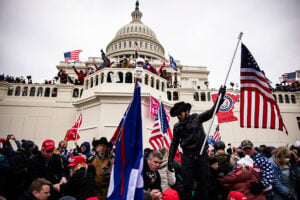New Trump Coup Memo Just Dropped
Meet Ken Chesebro, Co-Conspirator 5.

(Photo by Samuel Corum/Getty Images)
On November 19, 2020, Rudy Giuliani, Sidney Powell, and Jenna Ellis leaked hair dye and brain matter all over the podium at the RNC. The subsequent antics of the Elite Superfriends Kraken Derp Squad provided endless laughs and at least 100,000 words in these very columns.
But shorn of their outlandish fraud claims, which were almost immediately debunked, is one basic idea: making it easier to vote is cheating, and thus millions of ballots cast by qualified voters who believed they were complying with the law should be thrown out.

Documenting Secured Transactions: A New Guide For Practitioners
It’s a wildly undemocratic argument, which is why Trump and his henchmen continue to flog nonsensical fraud claims — the dogwhistle about two Black poll workers in Atlanta feeding thousands of fraudulent ballots into tabulators is a lot easier to sell than “Republican election officials changed the settings on the signature matching machines, and we’re pretty sure some of those votes were fraudulent, so, uh, let’s toss ’em all out.”
But behind the scenes, the less floridly insane lawyers were constructing a game plan to overthrow democracy based on a theory that increased ballot access justifies mass disenfranchisement. While Rudy and Sidney spun bizarro conspiracy theories for the cameras, intellectual “heavyweights” like John Eastman and Kenneth Chesebro were quietly crafting instruction manuals for a coup in bloodless legalese.
Thanks to his speech on the Ellipse and courtroom battles to hide his emails, Eastman gained notoriety and a role as “Co-Conspirator 2” in the January 6 Trump Indictment. But Chesebro, AKA “Co-Conspirator 5,” has flown relatively under the radar. A former editor of the Harvard Law Review and experienced corporate attorney, Chesebro guided the Trump campaign’s fake electors scheme in three legal memos which were mentioned in the indictment.
Yesterday the New York Times published the second of those memos, written on December 9, establishing the need for both pretextual litigation to substantiate the claim that the election results remained in doubt and effective “messaging” to convince the public that swearing in “alternate” slates of electors was “a routine measure.”
Sponsored

Documenting Secured Transactions: A New Guide For Practitioners

LawPay Pro Offers Upgraded Time And Billing Essentials

Clio Users: New Ways To Add Value To Your Practice!

The Digital Transformation Imperative

In Cheseboro’s estimation, for Pence to reject electors he would have to be able to point to “pending, on January 6 , in each of the six States, at least one lawsuit, in either federal or state court, which might plausibly , if allowed to proceed to completion, lead to either Trump winning the State or at least Biden being denied the State.”
Cheseboro, like Eastman, acknowledged that his plan would likely fail in the Supreme Court. But he seemed content to yaddayaddayadda whatever would happen once Pence tossed out tens of millions of swing state ballots on January 6:
I think the count could be managed so that Biden would have to seek Supreme Court review either when he is behind 12-0 in the electoral count or, at latest, when he is behind 232-227. Even if, in the end, the Supreme Court would likely end up ruling that the power to count the votes (in the sense of resolving controversies concerning them) does not lie with the President of the Senate , but instead lies with Congress (either voting jointly, or in separate Houses) , letting matters play out this way would guarantee that public attention would be riveted on the evidence of electoral abuses by the Democrats, and would also buy the Trump campaign more time to win litigation that would deprive Biden of electoral votes and/or add to Trump’s column.
“I’m not necessarily advising this course of action,” Cheseboro hedged, before laying out in exacting detail how to “create a scenario under which Biden can be prevented from reaching 270 electoral votes, even if Trump has not managed by then to obtain court decisions (or state legislative resolutions) invalidating enough results to push Biden below 270.”
As for the spin, Cheseboro cited both the “Hawaii precedent,” which has been widely debunked, and various liberal commentators such as Van Jones, Lawrence Lessig, Sherrilyn Ifill, and even Larry Tribe, for whom Cheseboro was a research assistant at Harvard.
Sponsored

The Digital Transformation Imperative


Survey Results: A Perspective On The Private Markets
This last provoked a furious dissent from Tribe at Just Security.
“I can say with confidence that the proposition that Chesebro misattributes to me is one I have never embraced,” he wrote.
Chesebro cites my writing as though it stands for the radical claim that it would be wrong “to view the Electoral Count Act as tying the Senate’s hands, unless amended” (emphasis added). That is, he averred that the Electoral Count Act could be flouted without a subsequent amendment or revocation by Congress.
What’s worse, as a result of this misrepresentation, Chesebro put me in the (outlandish) camp of those suggesting that the Electoral Count Act can be disregarded – for example, by a unilateral vice presidential decision to deem it “unconstitutional.”
It’s clear that Cheseboro and Eastman were brought in to provide a patina of legitimacy for a plan which involved more than a little “light criming.” And in some sense, Eastman has now stopped pretending that their plan was ever legal, and simply justifies it as necessary to fight a liberal elite which hates America.
Coincidentally, Eastman has now asked that the disbarment proceedings against him in California be stayed because he expects to be indicted imminently. The wages of sin…
Previously Secret Memo Laid Out Strategy for Trump to Overturn Biden’s Win [NYT]
Elizabeth Dye lives in Baltimore where she writes about law and politics and appears on the Opening Arguments podcast.







